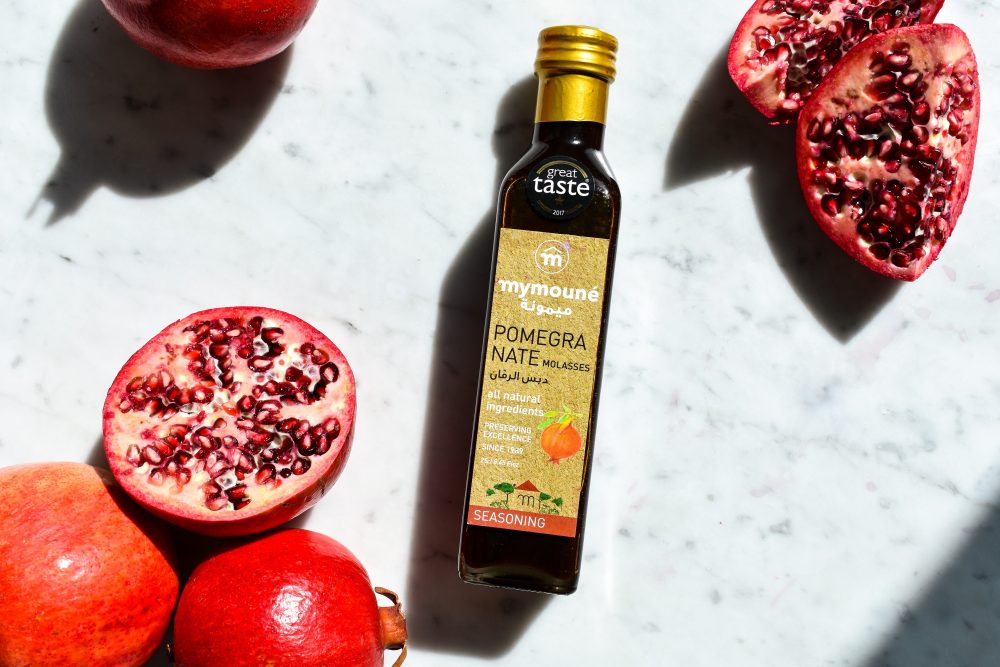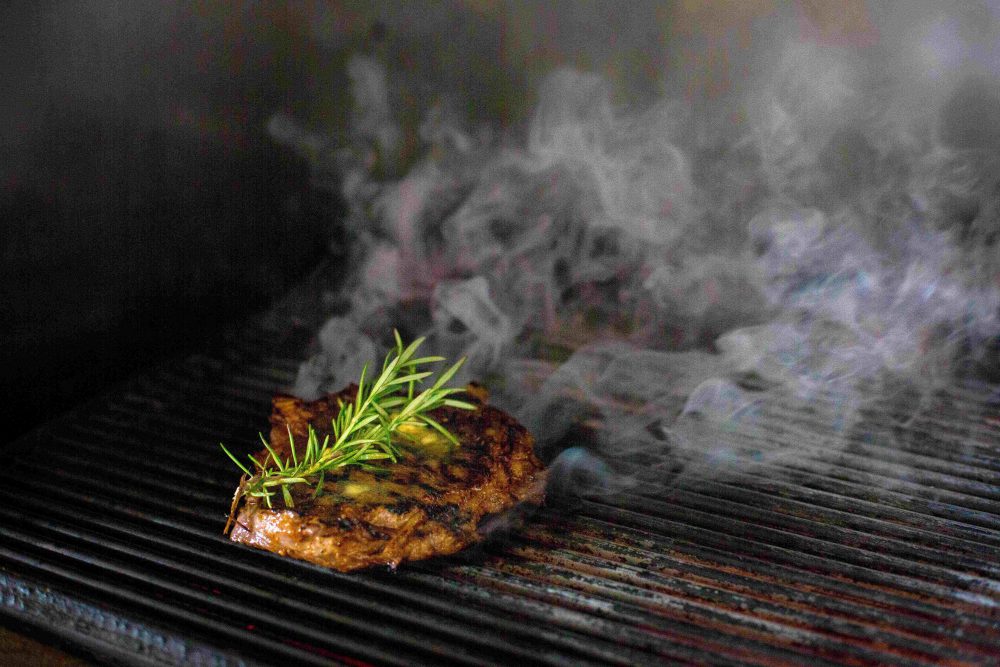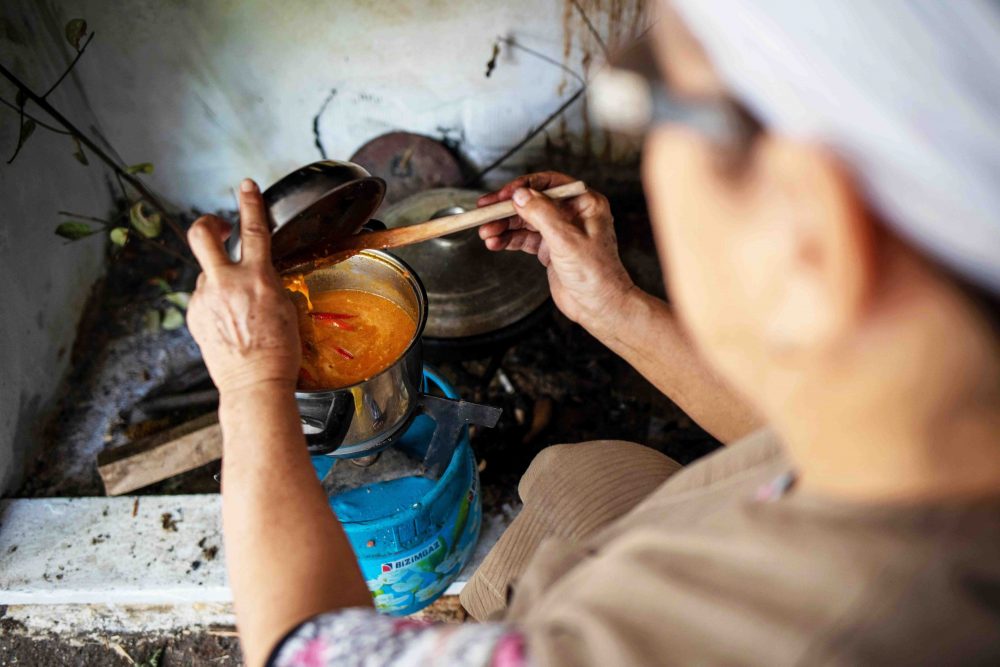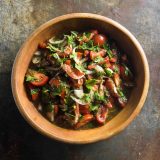
How to Change Your Cooking With Pomegranate Molasses
Here at Milk Street, pomegranate molasses is the key to building flavor quickly and easily.
A hollow twock, twock, twock echoes from a shaded patio behind a white house, the audible calling card of an ancient ritual in this corner of southern Turkey. With flat wooden dowels in one hand and split-open pomegranates in the other, a cohort of women in headscarves whack the mottled red shells to loosen ruby-red gems from the fruits’ pithy membranes.
Ayşe Kurnaz begins the assembly line by slicing off the top of each pomegranate. She makes two crosswise cuts and opens the fruit like a flower before passing it to the others, who pound pomegranates by the hundreds until plastic tubs are brimming with shimmering seeds, called arils. Some will be saved to garnish desserts, salads and even savory pilafs. But the majority will be juiced and boiled for hours in a cauldron over an open flame to thicken into the bright, ubiquitous mainstay of Turkish cuisine, pomegranate molasses.
The syrup is now becoming better known in the United States, though it still is largely misunderstood thanks to the term “molasses,” which sounds syrupy sweet. In fact, the sauce is mouthwateringly tart, and the name Turks use for the most common variety—nar ekşisi— translates as “pomegranate sour.”
I knew before I arrived that cooks here use it to impart a complex acidity, stirring it into bulgur side dishes, mixing it with rice for stuffed grape leaves, shaking it with oil for vinaigrettes and more. But what I would come to learn over a week of eating around Turkey was that it’s much more than a bright condiment used raw.
Though shunned by some traditionalists, cooking the syrup with other ingredients mutes its bracing acidity as it enriches the flavors of sauces, marinades and soups. A finishing raw drizzle adds a sharp, bright layer that reinforces the pomegranate flavor while balancing its own cooked richness. One ingredient, two flavors.

The molasses gives this steak flavor and char.
I’d been on the pomegranate trail since Istanbul, where street vendors rely on brilliant stacks of cut fruit to advertise the sweet-tart, freshly squeezed juice for about $1 a cup. That the stands seemed to be on every block reflects the abundance of pomegranates in this region, so important to the culture that they’re given as wedding gifts to symbolize fertility and smashed on doorsteps on New Year’s Eve.
The Kurnaz family found me, in a way, after my original plans fell through. A woman I’d arranged to visit in Toparlar had few pomegranates left by the time I arrived at her roadside stand—50 pounds yield only about 4 cups of molasses. But she assured me somebody must be making it. It’s early November, after all, and families here have been making molasses this time of year for thousands of years.
I catch wind of a community mill where families juice their seeds and head toward the center of town, but within minutes the high-pitched honk of a scooter makes it clear that someone is chasing me. Word had gotten out about my search, and a diminutive old man wearing a helmet several sizes too big, chin strap dangling, was dispatched to lead me down a side road to Kurnaz’s picturesque patio.
The rhythmic whacking announces itself before we do, and Kurnaz rises from her work to offer potent coffee and Turkish delights. She hands me a section of pomegranate, and I gnaw out the fruity pearls until juice squirts out, staining my shirt. It’s deliciously sweet but also shockingly sour, an indicator that these smaller pomegranates are perfect for molasses.
“Many people do it with the wrong one. The fruit has to be sour,” Kurnaz says. “In this area, it’s only me who makes it right.”
More women show up to help, filling tubs until mounds of arils are transferred to an orange sack. Kurnaz’s husband, Recep, a retired bulldozer operator, fishes through a storage shed for rubber boots, then lugs the sack onto a metal trough. Holding on to the roof of a carport for balance, he stomps on the sack as crimson juice cascades into a kiddie pool-sized tub.
Sadly, Kurnaz would not be reducing the juice until the following day—too many pomegranates left to seed—but she describes the process: There are two fires, a deep cauldron on one and a wide, shallow pan on the other. Once the juice simmers in the cauldron, she transfers it a few ladles at a time to the pan, which speeds reduction and, she says, better preserves the color.

A view of mountains surrounding the town of Söğüt welcomes diners at local restaurant Manzara.
Indeed, the remainder of her batch from the previous year is a rich maroon, runnier an sourer than the dark, syrupy pomegranate molasses sold in the U.S., which likely has added sugar, starch and flavorings. Kurnaz adds only a bit of salt for balance and as a preservative. The flavor is tart but complex, with fruity, floral aromas and a lightly caramelized sweetness.
Besides mixing molasses with all the usual suspects, Kurnaz says her family also eats it at breakfast, dipping bread into a mixture of it and olive oil and red pepper flakes. But she really piques my interest when she starts talking about beans. They’re prepared with a spicy-tart sauce with grated tomato, chili peppers, paprika and garlic, which are simmered with several tablespoons of pomegranate molasses. Another drizzle goes on top for two layers of flavor.
“Fava beans or dried eggplants, whatever you have, you put in it,” Kurnaz says. “This sauce is basically the base.” Add hot water or broth to the base and it becomes ikşili çorba, or sour soup, which Kurnaz offers to whip up.
Crouching over a propane burner outside, she sautés chili peppers in oil, sending up spicy aromas, then adds corn flour to make a roux. She grates tomato into the pot, then whisks in sweet paprika along with hot water. When it boils, she adds smashed garlic and pomegranate molasses. Once simmered, the soup gets a finishing drizzle of molasses.
It takes 15 minutes, start to finish, but the soup has a richness that suggests hours of cooking. The peppers’ spice is balanced by the deeper, cooked molasses, and the bright drizzle freshens the flavor; it’s surprisingly complex.
Later that night, I see the more sophisticated side of pomegranate molasses at Manzara, a family-owned restaurant in Söğüt with a wall of windows overlooking mountainous coastal terrain. As the table fills with one dish after another, the molasses shows up in at least half—including a simple yet tasty tomato, parsley and onion salad with a tart dressing.
“In general, it’s being used in salads. But as the Turks don’t like eating herbs much, we need to somehow enhance the flavor,” says co-chef Naci Isik. “So you can consider this as, what balsamic means to the Italians, pomegranate molasses means to the Turks.”
The restaurant shares the hallmarks of most seaside restaurants in Turkey, with a foundation in regional cuisine and a glass case displaying many of the same meze, or small plates, found elsewhere. Isik’s father, who opened the place in 1999, still cooks, his mother makes the baklava and breads, and cousins and spouses fill out the staff, all born in the village. But the menu has taken a modern turn since Isik and his brother, Ali, took control, showing a willingness to experiment with traditions like pomegranate molasses.
A whole grilled grouper, for example, comes with a pomegranate vinaigrette as a dipping sauce, the tartness complementing the meaty fish without overpowering its delicate flavor. Isik’s puckering syrup, thicker than Kurnaz’s, also shines in a ceviche with avocado, a salad of charred eggplant and a drizzle over seared tuna. But the most surprising dish is a pomegranate-marinated rib-eye, a juicy steak that reinforces what I’d learned from Kurnaz: Cooking with the molasses showcases its versatility.
In the kitchen, Isik grates an onion, squeezes the juice out, and rubs the juice and pulp on the steak. He covers it with chopped rosemary, oily pepper flakes made from the sweet kapya varietal, lots of black pepper and a hearty glug of pomegranate molasses. The meat will rest briefly, but often he lets it sit overnight for stronger flavor.

Ayşe Kurnaz’s ikşili çorba (sour soup) gets richness from pomegranate molasses.
As the steak cooks over medium-hot charcoal, Isik sets a burning rosemary sprig on the meat for another layer of smoke. The steak comes off the grill coated in a savory sauce that merely suggests pomegranate, the hint of sweetness helping to balance the fine bits of char where the marinade met the grill—so subtle, I never would have known the pomegranate molasses had been in the marinade by taste alone.
It also was easy to replicate at Milk Street, where we often take a skeptical eye toward marinades because their flavors tend to do a poor job of penetrating meat. But in this case, the technique proved surprisingly effective.
“In this area, it’s only me who makes it right.”
That’s mostly because the steaks were thin enough and the marination long enough that a sufficient amount of flavor penetrated to make the effort pay off. And it turns out, the grated onion also played a role. Grating the onion releases pungent, water-soluble flavor compounds that, like salt, slowly penetrate the meat.
The result—thanks to simple yet pungent ingredients that do the work for us—was a steak with a meatier, more savory flavor. It also proved to be the rare case where it was worth taking the time to marinate.





